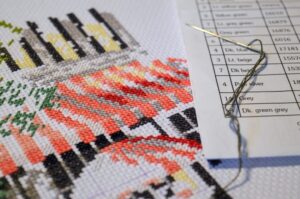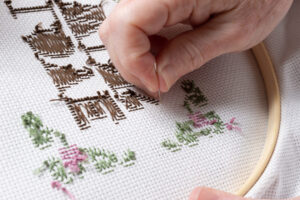These 7 cross stitch hacks can help any stitcher improve the quality of their finished work.

One of the things I adore about cross stitch today is the open-handed generosity of stitchers. From charts to flosses and everything in between, stitchers share what they have and what they know about this art and craft we all love. Even better, they’re often as free with their advice as with their stash! No matter what problem you’re having with the project in hand, if stitchers are around at least one of them will know how to solve it.
Where I currently live, cross stitchers are far to seek. I do still dream of living in a place where stitchers abound. But until that comes true I’m happy to share what I know with you!
So, without wasting any more keystrokes, here are my
7 cross stitch hacks for great-looking finishes
-
- Wash your hands before you handle your project. Hand washing removes accumulated sweat, oils, and grime from the skin of your palms. These residues can discolor the work, sometimes before you’ve gotten it out of the hoop. To make that finished project a treasured keepsake for decades to come, make sure to keep your hands clean. And, if you need to moisturize your dry hands due to frequent washing or from living in forced-air heating? Make sure to choose one that absorbs into your skin quickly and will leave no additional residue on your project.
- Get a daylight bulb for your lamp. Most of you probably already know that light can be produced in a range of “temperatures.” Over the years, most of us have gotten accustomed to the “soft white” of incandescent bulbs. But, their cooler temperature and reduced brightness don’t do well for those of us who work with closely shaded colors. I recommend a “daylight” bulb or lamp for most of stitchers. That’s in the 3100 to 4500 Kelvin range, if you’re shopping. It’s not so bright-white as to cause eye strain. Yet it will still let human eyes to sort through closely shaded colors without squinting. This helps you to identify when older flosses fade or begin to look “off” when compared to the color of a new skein. And that will definitely improve the quality of your finish.
- Change out your needle regularly. Most stitchers tend to overlook the condition of their needles, and I’m no exception. Even if you’re using good quality needles, the protective finish will wear away eventually. The needle will begin to catch ever-so-slightly as it’s pulled through fabric. This is hard on the fabric, and makes stitching harder on your hands than it has to be. Additionally, needles can bend if you grab them tightly enough—and we’ve all done it at least once. When this happens the holes collapse, and they’re a pain in the tushy to thread! So, do yourself a favor and break out a fresh needle with every new project. If you’re using more than one needle in a project (thread parking, anyone?) you may have to find a way to remind yourself to inspect your needles after “x” number of stitches. I think 10,000 stitches is usually about right, but then I’m rough on my kit, so your mileage may vary.

- Dedicate these two tools to your craft: Snips and tweezers. A good pair of snips is a joy to use, and a bad pair is “shear frustration.” The same is true for tweezers, only without the silly pun. Seriously, if you haven’t yet, get you a pair of sharp snips and a pair of needle-nosed tweezers and reserve them for your stitching kit. Don’t cut anything with the snips thicker than embroidery floss unless you want to ruin the shearing tension. And, why tweezers, you may be asking? If you have hair, or live with anyone or anything that has hair or fur, you’re going to need a way to pluck the strays from the fabric. If you try to ignore them, they will twist up the floss and reduce its coverage over each stitch-square, which is maddening. Be sure to keep the pointy tweezer tips covered with the protective sheath that probably came with them. Their usefulness is in how tightly the tips “tweeze” together, so it pays off to keep them as sharp as you can.
- Wash your project when you’ve completed it. As you handle that project through its life as a work in progress (WIP), it’s going to collect sweat, grime, dust, and dander from you and your environment. Guaranteed. Even if you can’t see that junk, I promise you, it’s there. Now, smaller projects that you can finish in an afternoon or two may not need to be washed. But, anything you’ve been handling for longer than that certainly will. Be sure to use a mild detergent, not soap. Almost any will do. In fact, I used dish-washing liquid for years before I switched to a special detergent just for my stitching. Use cool water. Rinse well. Allow to air dry out of direct sunlight. You may want to leave it covered with a clean towel, to protect it from further invasions of dust and dander while it dries. The only exceptions to this are for non-colorfast fibers. You should find this information on the labels of most fabrics and flosses. But if it’s not there and you don’t know for sure, wet a paper towel and dab the end of the floss skein or a tiny corner of your fabric until the fiber is saturated. If the paper towel stays remains uncolored, it’s reasonably colorfast.
- Set a timer to check in with your body while you are stitching. It happens to us all. After a few hours of blissing out with needle in hand, we look up and realize that something hurts. It could be from how you were holding your wrist, or that you had your shoulder jacked up. If you’re like me and tend to slump over your work rather than holding it up, your neck and back are going to hate you. These are the kinds of strains and injuries that cause tension in arms and hands. That tension often results in uneven thread tension in your stitches. It’s not a huge detriment, but the eye can tell those stitches are not “resting” correctly. And then, you’re probably going to lose some stitching time while your body heals, which blows. So look, just set a timer. Nearly everyone has a mobile device these days, and those devices have clock apps. And clock apps include timers! Or you could even download a fancier app from your favorite app store if you like! The point is to find the right tool to alert you when you’re in danger of harming yourself from doing so much of what you love.


Photo by Benjamin White on Unsplash - Lastly, accept that the “mistakes” you made during stitching were necessary to make the project uniquely yours. Nature never duplicates anything exactly. There are always tiny little “imperfections” in the replication that will difference a copy from the original. Those tiny mistakes you made in counting, or in placement or floss choice, are what make the finish unique to you. No other stitcher will ever be able to stitch it exactly the way you did—and this is a feature of the hobby, and of your finishes. Not a bug!
I hope you find these 7 cross stitch hacks helpful. And you know, if you’ve got a favorite tip or hack that makes cross stitch better for you, won’t you share it with us in the comments? Thanks!
- Too Old for Snapchat Too Young for LifeAlert - November 2, 2023
- Fast 5: Ways to Destress Yourself with Cross Stitch! - October 31, 2023
- October 2023 is Menopause Awareness Month! - October 5, 2023





